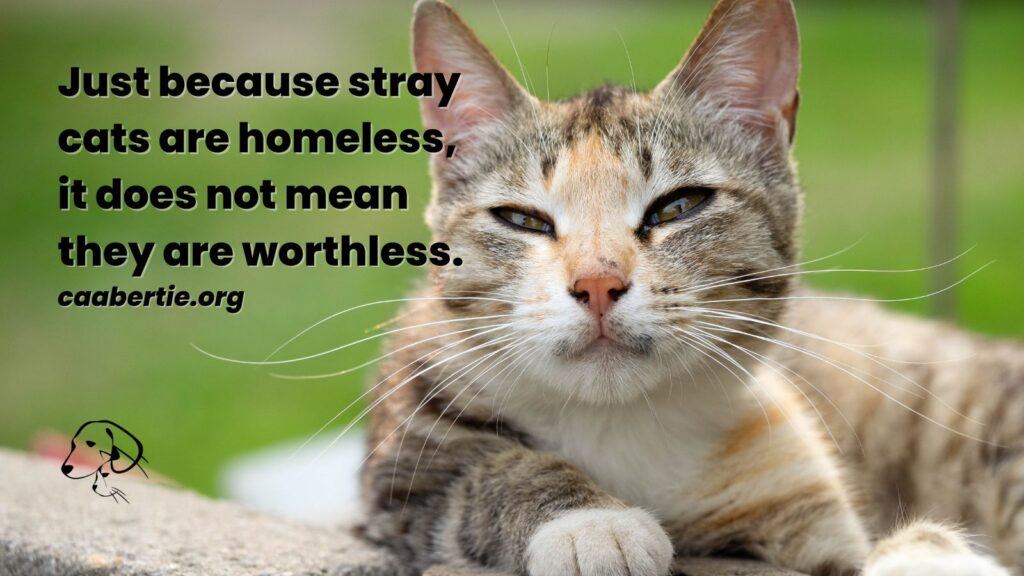Feral cats are widespread throughout Bertie County. However, it’s not only a problem here in Bertie County but an issue throughout the entire United States.
Most people don’t mind one or two stray cats on their properties. Who doesn’t love a good mouser? The objection to allowing the cats to stay on a property is that one or two cats can turn into a large colony of cats. An act of compassion can spiral out of control faster than imagined.
Cats Should Be Companion Animals
Companion Animal Advocates of Bertie’s position is that cats should be indoor pets–companion animals. However, the stark reality is that we have a multitude of strays throughout the county–and the problem is not getting better on its own.
CAABertie is a pet advocacy group. Our volunteers cannot assist with trapping, taking custody of, or removing animals for residents. Instead, this page will you with a possible tool and a link to apply for funding that pays the veterinarian’s bill as part of a citizen-oriented trap, neuter, release (TNR) program.
Our primary focus remains on advocating for companion animals. Still, this information seemed worthy of sharing with Bertie County residents who may face the challenges of managing a feral cat colony.

How to Deal With Feral Cats (Population Control of a Feral Cat Colony)
The only humane and responsible way to manage a feral cat colony is to prevent reproduction. Some adult stray cats will survive harsh weather or predators and avoid vehicle strikes; however, others will not make it. Spaying and neutering will allow the colony to run its course naturally.
Here is why it is so essential.
A feline pregnancy is only 63-65 days of gestation–just over nine weeks. To worsen the overproduction crisis, a female can go into heat within just a few weeks of the birth of her kittens. Contrary to what some people believe, they can even become pregnant again while still nursing. In other words, a fertile female cat could produce a litter approximately every three to four months.
Let’s do a bit of quick cat math. Fifty-two weeks per year divided by twelve weeks (which includes a couple of weeks for the mama kitty to go back into heat) equals four litters per year. If the cat averages just four kittens per litter, that means sixteen more cats. The problem exponentially grows when you multiply that by all the cats within a feral colony.
Spaying and neutering is the only solution.
Bertie County and Feral Cats–A Challenge We Must Tackle
Bertie County, a Tier One county in North Carolina, faces systemic challenges due to severe underfunding and a lack of resources. We have two animal control officers doing their best to cover 741 square miles–an enormous land mass.
Residents who call Bertie County Animal Control with complaints regarding feral cat colonies taking over their yards or neighborhood usually hear that the sheriff’s department cannot assist with catching cats. The problem is enormous, and it’s unrealistic to expect two officers to capture all the stray dogs and cats in the county and investigate animal abuse. Unless the feral cat appears rabid or dangerous, they generally cannot assist with the cat nuisance calls.
This leaves residents to deal with feral cats alone, often with cruel and tragic outcomes.
Companion Animal Advocates of Bertie knew there had to be a better way–and we found a resource for citizens who want to do the right thing for feral cats but perhaps could not afford to spay or neuter all the feral cats in their area.
Trap Neuter Release (TNR) Funds for Individuals Who Want to Sterilize Stray Cats
Spay USA believes engaged citizens are the key to humanely resolving the stray cat problem across the country.
They offer a subsidy program to individuals only. These funds are not for pet owners, governments, shelters, rescue agencies, non-profits, or other organizations. Their program is based on the humane trap, neuter, release (TNR) methods, specifically for stray cats. Spay USA sets aside this money for good people who don’t wish to harm feral cats but rather to manage the colony until it eventually ages and dies out.
Their website explains this:
SpayUSA feels the best way to solve feral cat overpopulation is at a grassroots level, meaning developing a Cat Project group in your town, city, or county. Many models for these projects already exist, but all you need to begin is a humane trap and a little patience.
SpayUSA offers subsidy funding for stray and feral cat caretakers throughout the US. The application is open to INDIVIDUALS ONLY and is not for animal shelters or other rescue groups. Additionally, this funding is only to be applied to stray, feral, and unowned cats; pet cats are not eligible to receive funding. Our aim is to help Good Samaritans looking to do their part in controlling the over population of community cats in their area.
Spay USA
Citizens willing to do so can sterilize the strays in their area. The citizen must purchase or borrow a live trap to catch the feral cats in their neighborhood, transport them to the vet, and re-release them post-surgery. Spay USA accepts applications for the program monthly. Funds go directly to the citizen’s vet of choice.
To learn more about how to apply for these funds, contact Spay USA by calling (800) 248-7729. You can also email them at spayusa@animalleague.org.
